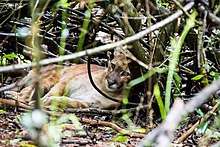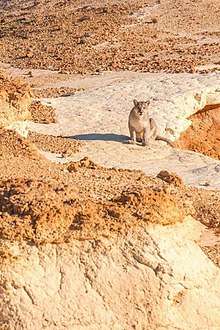South American cougar
| South American cougar | |
|---|---|
 | |
| Cougar at Iguaçu National Park, Brazil | |
| Scientific classification | |
| Kingdom: | Animalia |
| Phylum: | Chordata |
| Class: | Mammalia |
| Order: | Carnivora |
| Suborder: | Feliformia |
| Family: | Felidae |
| Subfamily: | Felinae |
| Genus: | Puma |
| Species: | P. concolor |
| Subspecies: | P. c. concolor |
| Trinomial name | |
| Puma concolor concolor (Linnaeus, 1771; Gay, 1847; Pelzeln, 1883) | |
| Synonyms[1] | |
| |
The South American cougar (Puma concolor concolor) is a population of the cougar in South America, living from Colombia and Venezuela to Peru, Brazil and Argentina. As of 2017, the Cat Classification Taskforce of the Cat Specialist Group recognises South American populations of the cougar as being P. c. concolor, possibly with the exclusion of the region northwest of the Andes Mountains.[2]
Taxonomic history
Initially, a number of subspecies were described for South America:[2]
- The type specimen for which Carl Linnaeus described Felis concolor in 1771 was from French Guiana.[1]
- In 1782, Molina described concolor puma from Chile.
- In 1940, Puma concolor cabrerae was proposed by Reginald Innes Pocock to be native to northern Argentina.
- In 1946, concolor capricornensis was described by Goldman from Brazil.
As of 2017, the Cat Classification Taskforce of the Cat Specialist Group recognizes only two subspecies: P. c. concolor and P. c. couguar.[2]
Ecology

The cougar preys on birds, deer, sloths, mice, frogs, agoutis, and lizards.[3] Sympatric predators include the spectacled bear, whose cubs the cougar may prey on,[4] and jaguar. In spite of coexisting with the larger jaguar[5] in places like Sangay National Park in Ecuador, the cougar's prey tends to be small.[3] They rarely prey on domesticated animals.[6]
In San Guillermo National Park, 80% of the cougar's diet is composed of vicuñas, while 11% is from mice, and 9% from hares. The cougar also preys on the guanaco.[7] When harassed by Andean condor, they may abandon their kills, which causes them to kill 50% more prey than North American cougars.[8]
Conservation
Cultural significance
The cougar holds historical cultural significance amongst many Southern Native Americans.[9] For example, the cougar's name was used for Incan regions and people.[10]
See also
References
- 1 2 Wozencraft, W. C. (2005). "CLXIV: Order Carnivora". In Wilson, D. E.; Reeder, D. M. Mammal Species of the World: A Taxonomic and Geographic Reference. 1 (3 ed.). Johns Hopkins University Press. pp. 544–545. ISBN 978-0-8018-8221-0. OCLC 62265494. 14000204.
- 1 2 3 Kitchener, A. C.; Breitenmoser-Würsten, C.; Eizirik, E.; Gentry, A.; Werdelin, L.; Wilting, A.; Yamaguchi, N.; Abramov, A. V.; Christiansen, P.; Driscoll, C.; Duckworth, J. W.; Johnson, W.; Luo, S.-J.; Meijaard, E.; O’Donoghue, P.; Sanderson, J.; Seymour, K.; Bruford, M.; Groves, C.; Hoffmann, M.; Nowell, K.; Timmons, Z.; Tobe, S. (2017). "A revised taxonomy of the Felidae: The final report of the Cat Classification Task Force of the IUCN Cat Specialist Group" (PDF). Cat News (Special Issue 11).
- 1 2 Nowell, Kristin; Jackson, Peter (1996). Wild Cats: Status Survey and Conservation Action Plan (PDF). Gland, Switzerland: IUCN/SSC Cat Specialist Group. pp. 1–334. ISBN 2-8317-0045-0.
- ↑ Servheen, C.; Herrero, S.; Peyton, B. (1999). Bears: Status Survey and Conservation Action Plan (PDF). Missoula, Montana: IUCN/SSC Bear Specialist Group. ISBN 978-2-8317-0462-3.
- ↑ "Sympatric Jaguar and Puma". Ecology.info. Retrieved 2015-01-11.
- ↑ "Cougar Subspecies". Panthera Corporation. Retrieved 2015-01-12.
- ↑ "The Study Subjects: Vicunas and Pumas Wildlife Ecology in San Guillermo National Park". University of Wyoming. Retrieved 2015-01-12.
- ↑ "Nuisance Ecology: Do Scavenging Condors Exact Foraging Costs on Pumas in Patagonia?". PLOS. January 3, 2013. doi:10.1371/journal.pone.0053595. Retrieved March 9, 2015.
- ↑ Tarmo, Kulmar. "On the role of Creation and Origin Myths in the Development of Inca State and Religion". Electronic Journal of Folklore. Kait Realo (translator). Estonian Folklore Institute. Archived from the original on June 30, 2007. Retrieved May 22, 2007.
- ↑ Berrin, Katherine & Larco Museum. The Spirit of Ancient Peru:Treasures from the Museo Arqueológico Rafael Larco Herrera. New York: Thames and Hudson, 1997.
.jpg)